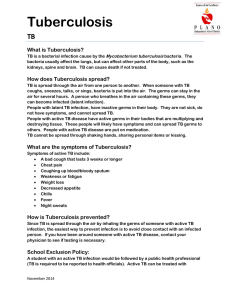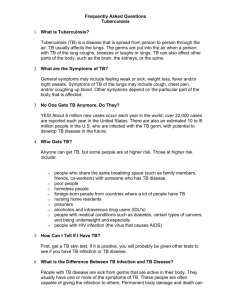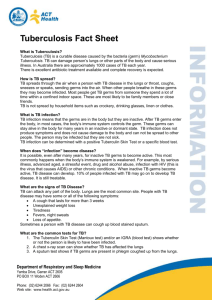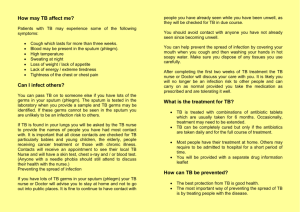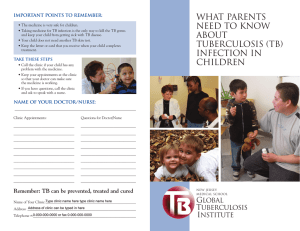Tuberculosis: Get the Facts!
advertisement
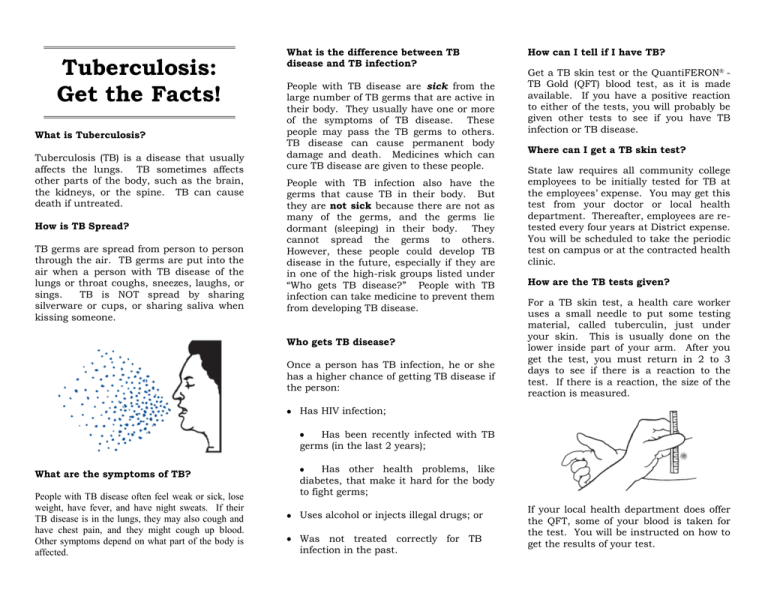
Tuberculosis: Get the Facts! What is Tuberculosis? Tuberculosis (TB) is a disease that usually affects the lungs. TB sometimes affects other parts of the body, such as the brain, the kidneys, or the spine. TB can cause death if untreated. How is TB Spread? TB germs are spread from person to person through the air. TB germs are put into the air when a person with TB disease of the lungs or throat coughs, sneezes, laughs, or sings. TB is NOT spread by sharing silverware or cups, or sharing saliva when kissing someone. What is the difference between TB disease and TB infection? People with TB disease are sick from the large number of TB germs that are active in their body. They usually have one or more of the symptoms of TB disease. These people may pass the TB germs to others. TB disease can cause permanent body damage and death. Medicines which can cure TB disease are given to these people. People with TB infection also have the germs that cause TB in their body. But they are not sick because there are not as many of the germs, and the germs lie dormant (sleeping) in their body. They cannot spread the germs to others. However, these people could develop TB disease in the future, especially if they are in one of the high-risk groups listed under “Who gets TB disease?” People with TB infection can take medicine to prevent them from developing TB disease. Who gets TB disease? Once a person has TB infection, he or she has a higher chance of getting TB disease if the person: How can I tell if I have TB? Get a TB skin test or the QuantiFERON® TB Gold (QFT) blood test, as it is made available. If you have a positive reaction to either of the tests, you will probably be given other tests to see if you have TB infection or TB disease. Where can I get a TB skin test? State law requires all community college employees to be initially tested for TB at the employees’ expense. You may get this test from your doctor or local health department. Thereafter, employees are retested every four years at District expense. You will be scheduled to take the periodic test on campus or at the contracted health clinic. How are the TB tests given? For a TB skin test, a health care worker uses a small needle to put some testing material, called tuberculin, just under your skin. This is usually done on the lower inside part of your arm. After you get the test, you must return in 2 to 3 days to see if there is a reaction to the test. If there is a reaction, the size of the reaction is measured. Has HIV infection; Has been recently infected with TB germs (in the last 2 years); What are the symptoms of TB? People with TB disease often feel weak or sick, lose weight, have fever, and have night sweats. If their TB disease is in the lungs, they may also cough and have chest pain, and they might cough up blood. Other symptoms depend on what part of the body is affected. Has other health problems, like diabetes, that make it hard for the body to fight germs; Uses alcohol or injects illegal drugs; or Was not treated correctly for TB infection in the past. If your local health department does offer the QFT, some of your blood is taken for the test. You will be instructed on how to get the results of your test. What if the test is negative? A negative skin test usually means you are not infected. However, the test may be falsely negative if you were infected recently. It usually takes 2 to 10 weeks after exposure to a person with TB disease for the skin test to react as positive. The test may also be falsely negative if your immune system is not working properly. A negative QFT usually means you are not infected. What if the test is positive? A positive skin test or QFT usually means that you have been infected with the TB germ. It does not necessarily mean that you have TB disease. Other tests, such as an x-ray or sputum sample, are needed to see if you have TB disease. What if I had the BCG Vaccine? BCG is a vaccine for TB. This vaccine is not widely used in the United States, but it is often given to infants and small children in other countries where TB is common. The BCG vaccine does not usually protect adults against TB. You may still get TB infection or TB disease. Even if you have had the BCG vaccine, you will need a QFT, chest x-ray, or consultation to see if you may have TB infection or TB disease. What should I do if I have TB infection or disease? Get the required follow-up tests. Follow your doctor's advice and take the medicine as prescribed. Today, both TB infection and TB disease can be treated and cured with medication. For additional information, call your local health department TB Control Unit at (213) 744-6160; or Visit the CDC Division of Tuberculosis Elimination Website at : http://www.cdc.gov/tb/pubs/pamphlets/TBgtfctsEng.pdf Los Angeles Community College District 770 Wilshire Boulevard Los Angeles, CA 90017 Tuberculosis: Board of Trustees Steve Veres, President Tina Park, First Vice President Nancy Pearlman, Second Vice President Kelly Candaele Mona Field Miguel Santiago Scott J. Svonkin Daniel Campos, Student Trustee District Administration Dr. Daniel J. LaVista, Chancellor Dr. Adriana D. Barrera, Deputy Chancellor Dr. Yasmin Delahoussaye, Vice Chancellor for Educational Programs and Institutional Effectiveness Dr. Felicito Cajayon, Vice Chancellor for Economic and Workforce Development Jeanette Gordon, Chief Financial Officer/Treasurer Camille A. Goulet, General Counsel James D. O’Reilly, Executive Director, Facilities Planning and Development Get the Facts! U.S. DEPARTMENT OF HEALTH AND HUMAN SERVICES Public Health Service This pamphlet is revised and reprinted from the U.S. Department of Health and Human Services – Centers for Disease Control and Prevention “Get the Facts” pamphlet. For additional copies, contact Business Services Division Risk Management-Environmental Health & Safety (213) 891-2422 LACCD EH&S TB Pamphlet-08/01/2012 Centers for Disease Control and Prevention National Center for Prevention Services Division of Tuberculosis Elimination Atlanta, Georgia 30333
